ATTRACTIONS
Central Italy is a treasure trove of beautiful landscapes and natural sites, lively towns and cities as well as unique archeological wonders. Below is a selection of our favorite places that can all be reached in less than an hour’s drive from Domus Civita in the 3 regions of Umbria, Tuscany and Lazio.
UMBRIA
Umbria has emerged from Tuscany’s shadow as a major destination. Its narrow borders contain a
dozen or more hill towns, each crammed with treasures. Its pastoral countryside has earned it the
designation as ‘the green heart of Italy’ and, as the birthplace of Saints Francis and Benedict. It is
also known as Italy’s mystical heart—‘the land of saints.’
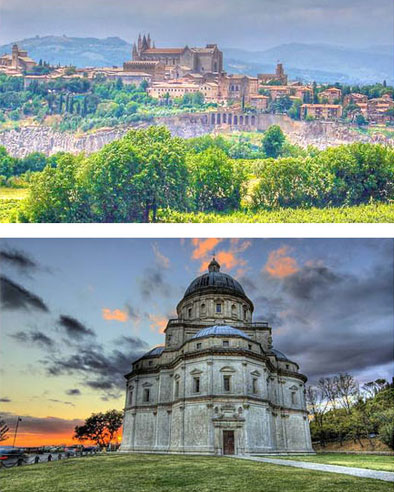
Orvieto
Orvieto is one of Italy’s most dramatically situated hill
towns commanding a position atop a 600-foot tufa
plateau. It dates from Etruscan times and boasts the
most beautiful Gothic cathedral in Italy as well as some
of Italy’s best known white wines. Frescos by Signorelli
inside the cathedral are believed to have inspired
Michelangelo’s Last Judgment in the Sistine Chapel in
Rome. Orvieto has many other visitable sites in
addition to being a great place to stroll, shop, and
enjoy the ambiance of a vibrant Italian town.
Todi & Spoleto
Todi and Spoleto are two of the most visited towns
of Umbria. Todi is the rising star of Umbrian hill towns
featuring a phenomenal position above the Tiber River
which goes on to flow to Rome and the sea. It has a
matchless ensemble of Medieval palaces, an excellent
museum, and a beautiful cathedral. Outside the walls
you will find a jewel-like central plan church attributed
to the renowned Renaissance architect Bramante.
Spoleto has long been the best loved Umbrian town
for international visitors. It has many noteworthy
churches, a lovely cathedral, and a picturesque piazza.
Its outstanding natural feature is a wooded gorge that you can cross via a fourteenth century bridge
and acqueduct which will take you to one of the most beautiful Romanesque churches in Italy.
Assisi
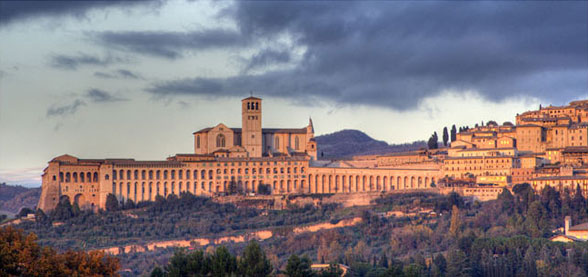 Assisi is the birthplace of St. Francis
and home to his burial place, the
enormous and beautiful Basilica of
St. Francis. The construction of this
impressive structure was a Medieval
architectural feat and it is still
considered one of the engineering
marvels of the period. The walls of
the lower and upper churches are
decorated with remarkable frescos,
the best known of which is one of
Italy’s most famous works, Giotto’s
Life of St. Francis. The town features
many other sights and spectacular
views of the Umbrian countryside from the castle. Despite some commercialization, Assisi’s delicate
pinks and grays, and the rocks, olive trees, churches in the valley below still convey a gentle
otherworldliness worthy of its most famous son.
Assisi is the birthplace of St. Francis
and home to his burial place, the
enormous and beautiful Basilica of
St. Francis. The construction of this
impressive structure was a Medieval
architectural feat and it is still
considered one of the engineering
marvels of the period. The walls of
the lower and upper churches are
decorated with remarkable frescos,
the best known of which is one of
Italy’s most famous works, Giotto’s
Life of St. Francis. The town features
many other sights and spectacular
views of the Umbrian countryside from the castle. Despite some commercialization, Assisi’s delicate
pinks and grays, and the rocks, olive trees, churches in the valley below still convey a gentle
otherworldliness worthy of its most famous son.
Foligno
 Foligno is a quiet, prosperous town at the center of an
essential piece of Umbria, a collection of four lovely hill towns
and a beautiful abbey, none further than eight miles from the
center of Foligno. A visit to this area will make an enjoyable
day trip. Trevi has perhaps the most glorious position of any
Umbrian hill town overlooking the Clitunno River valley. Its
Medieval heart is a delight to wander through and its olive
oil is prized. Bevagna in the Clitunno Valley is noted for it
central piazza, one of Italy’s most perfect Medieval squares.
Spello with its huddled mass of pink-hued houses on the slopes
of Monte Subasio looks like the quintessential Umbrian hill
town with Roman gates that are witnesses to its distinguished
history. Montefalco with its panoramic views of the entire
region is known as the “Balcony of Umbria.” On a clear day
you can see all of Umbria from Spoleto to Perugia. In
addition, it offers a museum featuring works by the most
famous Umbrian artists, a stunning fresco cycle of the life of
St. Francis by Benozzo Gozzoli in the Church of St. Francis,
and a maze of charming Medieval streets. For an extra
treat visit the nearby eleventh century Abbazia di Sassovivo which
contains Umbria’s finest cloister.
Foligno is a quiet, prosperous town at the center of an
essential piece of Umbria, a collection of four lovely hill towns
and a beautiful abbey, none further than eight miles from the
center of Foligno. A visit to this area will make an enjoyable
day trip. Trevi has perhaps the most glorious position of any
Umbrian hill town overlooking the Clitunno River valley. Its
Medieval heart is a delight to wander through and its olive
oil is prized. Bevagna in the Clitunno Valley is noted for it
central piazza, one of Italy’s most perfect Medieval squares.
Spello with its huddled mass of pink-hued houses on the slopes
of Monte Subasio looks like the quintessential Umbrian hill
town with Roman gates that are witnesses to its distinguished
history. Montefalco with its panoramic views of the entire
region is known as the “Balcony of Umbria.” On a clear day
you can see all of Umbria from Spoleto to Perugia. In
addition, it offers a museum featuring works by the most
famous Umbrian artists, a stunning fresco cycle of the life of
St. Francis by Benozzo Gozzoli in the Church of St. Francis,
and a maze of charming Medieval streets. For an extra
treat visit the nearby eleventh century Abbazia di Sassovivo which
contains Umbria’s finest cloister.
Perugia
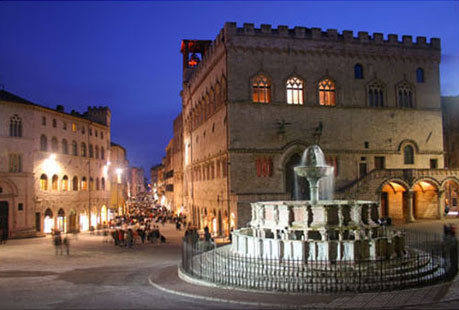
Umbria’s capital and largest city, Perugia, was
one of the twelve Etruscan city-states that
constituted the federation of Etruria in the seventh
and sixth centuries B.C. Today the massive
Etruscan walls and gates define the city center
that includes grand Medieval buildings as well
as a great university and wonderful museums.
The late afternoon passegiata on the Corso
is an experience that you will remember.
Against the imposing backdrop of its great
architecture the well-dressed inhabitants of the
town participate in the timeless ritual of the
see-and-be-seen evening walk. While this is a
standard feature in all Italian towns, Perugia’s
evening walk is one to remember.
LAZIO
Rome, the largest city in the region and Italy’s capital, dominates Lazio. Yet there is much to
discover in this region including phenomenal Etruscan sites, splendid volcanic lakes, and a unique
collection of villas and gardens, in addition to cities and towns steeped in history.
Lake Bolsena and the surrounding towns
The town of Bolsena sits at the eastern edge of the Lake Bolsena, a volcanic lake formed by an
eruption 250,000 years ago. Like so much of central Italy, Bolsena bears the signs of almost every
important period of the Italian peninsula, going back as far as the Iron Age and progressing
through the times of the martyrs, catacombs, miracles and on to the Middle Ages. Worth visiting
are the Castle, built by the Monaldeschi della Cervara family in the twelfth and fourteenth
centuries, the Complex of Saint Cristina with its fourth century catacombs, eleventh century basilica
and seventeenth century baroque church. Bolsena has also been known since Roman times for
its wine and eel. A stroll through the quiet historic center and by the newer Lungolago along the
lake will give you a good glimpse of Italian town life.
We recommend an excursion on the lake to visit the haunting Isola Bisentina and a swim in the
cool crystal clear, spring-fed lake water.
Other towns of interest around the lake include the picturesque fishing village of Marta and
charming Montefiascone with its beautiful views of the lake from the gardens of the now ruined
sixteenth century papal palace. For those interested in World War II history a visit to the Commonwealth
Cemetery along the slopes of the lake is both moving and informative.
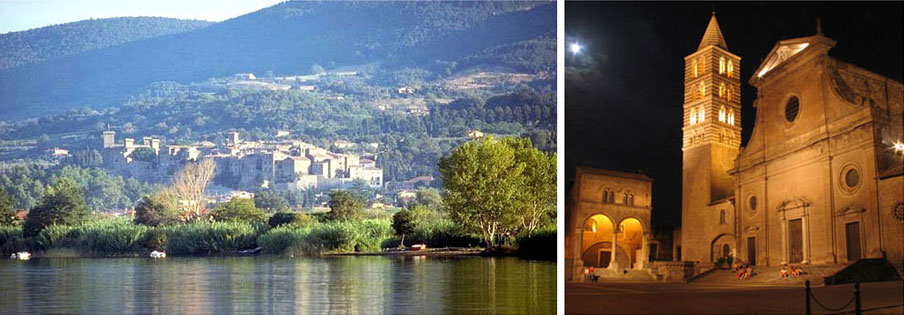
Viterbo
Viterbo’s origins are unknown. It was probably founded by the Etruscans but its existence
is verified for the first time in the eighth century. Starting in the eleventh century popes
made Viterbo their preferred residence hence the Papal Palace which functioned as a country
residence and a refuge in times of trouble in Rome. Viterbo’s historic center is today recognized
as one of the best preserved Medieval towns of central Italy. Worth visiting are the
Romanesque Cathedral of San Lorenzo, the Piazza del Plebiscito and its palaces, the Fontana
Grande and many gothic and Romanesque churches. Of interest are also the Museo Civico
(City Museum) which houses many archeological specimens from the pre-historical to Roman
times and the Pinacoteca with a fine collection of Renaissance paintings
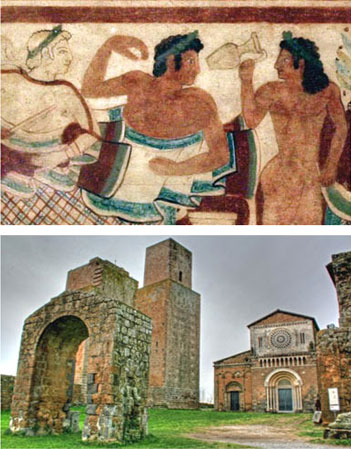
Tarquinia & Tuscania
Tarquinia was once the cultural and political capital of the
Etruscans and now features an Etruscan museum and tombs
as famous as any in Italy. The small museum houses the most
beautiful Etruscan sculpture in existence, a pair of winged
horses, as part of its excellent collection. Six thousand tombs
honeycomb a plateau east of town and feature historically
significant frescos open to only a handful of visitors at a time
due to their fragility. A visit to Tarquinia presents a unique
opportunity to appreciate the achievements of the most
important early culture of the Italian peninsula.
Legend has it that Tuscania was founded by Aeneas, founder
of Rome. it was an important city during Etruscan, Roman and
early Christian times. Today this honey colored town of tufa
boast impressive monuments from of all of these periods,
magnificent early Renaissance piazzas and the unique
Medieval church complex of St. Peter.
Historic Villas and Gardens
The historic gardens of Lazio reflect the history of Renaissance Rome, where the gardens of Ancient
Rome were recreated and redesigned by Renaissance architects. It is also the history of the great
Roman families who used the city’s splendid history to enhance their glory by commissioning the
design of palaces and gardens in the Lazio region, private worlds of beauty which we are
now privileged to share.
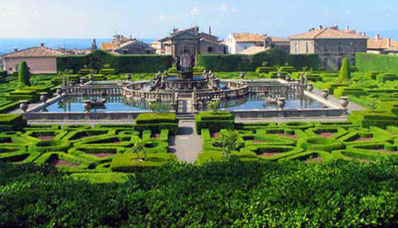
Villa Lante
Villa Lante, a garden with two small summer pavilions,
has come down to us almost unchanged since it was
completed at the end of the sixteenth century. It has been
admired for 500 years as the perfect example of a
Renaissance garden. Known for its symmetry and its
water works, it is considered a masterpiece of proportion
and perspective by the great architect Vignola.
It remains as enchanting and magical today as it was
at its creation.

Palazzo Farnese di Caprarola
Built on the foundations of a fortress, the architect Vignola created a great pentagon shaped villa for Cardinal Allessandro Farnese, a great patron of the arts. The beautiful
Renaissance retreat is best known for its monumental staircase,
beautifully frescoed Room of Maps of the World, and its south
facing summer garden and north facing winter terrace.
Dominating the tiny village of Caprarola, the palazzo and
gardens are at once majestic and serene. Nearby you will also
find Lago di Vico, a secret little lake in the crater of an ancient
volcano. Here you can hike forest covered slopes or drive the
Via Ciminia along the crater’s summit ridges.
Sacro Bosco di Bomarzo
In a park below a still visible castello, the Orsini family created
Lazio’s most extraordinary gardens: the ‘Park of Monsters’.
Grotesques, moss covered sculptures, and huge, fantastic stone
creatures give the effect of a sixteenth century fantasy theme park.
It is an original vision of mystery and menace that stands in
contrast to the restraint and elegance of Villa Lante only 8 miles
away.Children will be especially enchanted by this Renaissance
wonderland, but all will be fascinated by this unusual pleasure
garden.

Castello Ruspoli - Vignanello
Castello Ruspoli, in the village of Vignanello, boasts the
best preserved Renaissance parterre to survive anywhere
in Italy. It was planted to be seen from above—directly
under the windows of the Ruspoli family’s imposing fortress
in the historic Cimini Hills outside of Viterbo. The pattern
of the parterre, divided into twelve rectangular
compartments, is exactly as it was laid out 400 years ago.
To this day the castle is in the possession of the Ruspoli
family who have restored and saved the garden for
posterity.
TUSCANY
Southern Tuscany is Tuscany at its best—pastoral landscapes that are gentler and more varied than
those of the north, fascinating historic towns, tiny villages, and remnants of the Etruscan civilization
that gave the region its name. This area proves once again that there is always something new to
discover in Italy.
Pitigliano, Sorano, Sovana
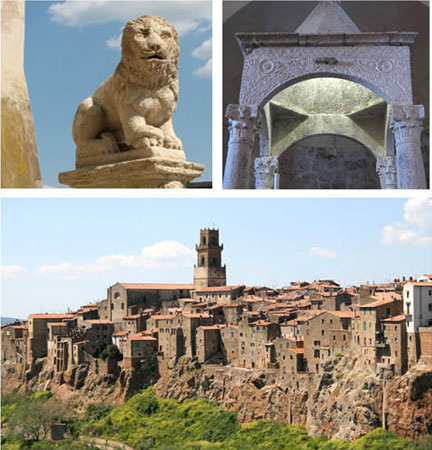 Pitigliano is a well preserved hill town known as the “Little Jerusalem” because of the presence of
a Jewish community that flourished up to the early 1900s. It sits on a beautiful tufa rock at the southern
end of Tuscany. It is known for its white wine, its beautiful landscape around the city and its Etruscan
tombs. Today Pitigliano still has a standing synagogue that is a testimony to its rich Jewish heritage.
Worth visiting are the Castle of the Orsini family, the Vie Cave, an intricate system of roads excavated
deep into the tufa rock that is a unique legacy of the Etruscans, the former Cathedral of Saint Pietro e
Paolo and the church of Santa Maria.
Sorano’s history is tied closely to that of Pitigliano.
The city is of Villanovan and Etruscan descent and
is built almost entirely of local tufa stone. It also
boasts a rich Jewish history. Sites worth visiting are
the Castle of the Orsini from which you can enjoy
a beautiful view of the town below, the Masso
Leopoldino in the center of the old town.
While tiny Sovana has only two streets and one
square, it is as historically interesting a village
as you will find in Italy. It is as old as the
Etruscans, was the power base of the noble
Aldobrandeschi family, and is the birthplace of
a pope. This rich history accounts for the
presence of one of Tuscany’s most beautiful
parish churches with its remarkable frescos and
ninth century ciborium. In addition, the surrounding
countryside is scattered with hundreds of Etruscan
tombs including the famous Tomba Ildebranda,
considered Tuscany’s finest single tomb.
Pitigliano is a well preserved hill town known as the “Little Jerusalem” because of the presence of
a Jewish community that flourished up to the early 1900s. It sits on a beautiful tufa rock at the southern
end of Tuscany. It is known for its white wine, its beautiful landscape around the city and its Etruscan
tombs. Today Pitigliano still has a standing synagogue that is a testimony to its rich Jewish heritage.
Worth visiting are the Castle of the Orsini family, the Vie Cave, an intricate system of roads excavated
deep into the tufa rock that is a unique legacy of the Etruscans, the former Cathedral of Saint Pietro e
Paolo and the church of Santa Maria.
Sorano’s history is tied closely to that of Pitigliano.
The city is of Villanovan and Etruscan descent and
is built almost entirely of local tufa stone. It also
boasts a rich Jewish history. Sites worth visiting are
the Castle of the Orsini from which you can enjoy
a beautiful view of the town below, the Masso
Leopoldino in the center of the old town.
While tiny Sovana has only two streets and one
square, it is as historically interesting a village
as you will find in Italy. It is as old as the
Etruscans, was the power base of the noble
Aldobrandeschi family, and is the birthplace of
a pope. This rich history accounts for the
presence of one of Tuscany’s most beautiful
parish churches with its remarkable frescos and
ninth century ciborium. In addition, the surrounding
countryside is scattered with hundreds of Etruscan
tombs including the famous Tomba Ildebranda,
considered Tuscany’s finest single tomb.
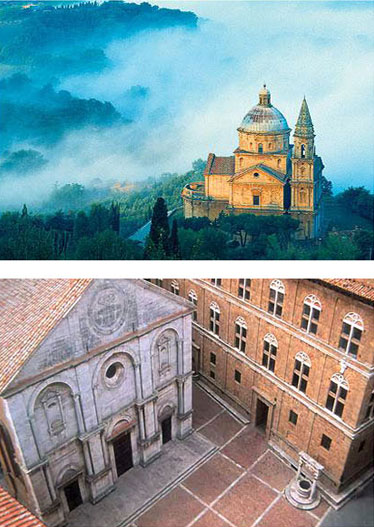
Montepulciano & Pienza
Perched on the crest of a volcanic hill since the sixth
century, Montepulciano has numerous religious and
secular buildings highly influenced by Florentine
Renaissance architecture and is the birth place of the
famous poet Politian. A stroll through the old town and
a visit to the majestic Piazza Grande will charm any
visitor. The views of the town and its environs from the
tower of the Town Hall are magnificent. The Church
of the Madonna di San Biagio just outside the Porta al
Prato is a Renaissance masterpiece by Antonio da
Sangallo and a highlight of Montepulciano. The town
is also famous for its Vino Nobile, a delightful red wine
made from Tuscany’s famed Sangiovese grapes.
Pienza is the Renaissance city built by architect
Rossellino and Pope Pius II Piccolomini. The historic town
center is the most important example of an early
renaiassance city planning that brought together civil
and religious authorities. The Palazzo Piccolomini
and the views of the Val d’Orcia from its courtyard are
breathtaking in every season. The Cathedral is worth a
visit and a stroll in the narrow streets of Pienza is a must.
Don’t forget to taste the Pecorino cheese selections that
add to the fame of this delightful Tuscan town.
|